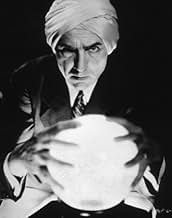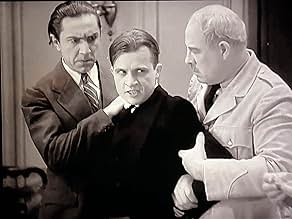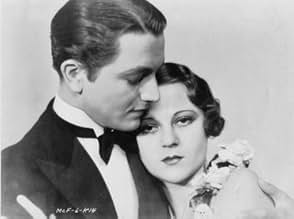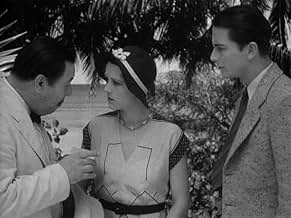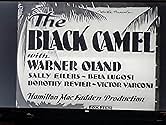NOTE IMDb
6,6/10
1,8 k
MA NOTE
Ajouter une intrigue dans votre langueThe unsolved murder of a Hollywood actor several years earlier and an enigmatic psychic are the keys to help Charlie solve the Honolulu stabbing death of a beautiful actress.The unsolved murder of a Hollywood actor several years earlier and an enigmatic psychic are the keys to help Charlie solve the Honolulu stabbing death of a beautiful actress.The unsolved murder of a Hollywood actor several years earlier and an enigmatic psychic are the keys to help Charlie solve the Honolulu stabbing death of a beautiful actress.
- Réalisation
- Scénario
- Casting principal
Dwight Frye
- Jessop
- (non crédité)
C. Henry Gordon
- Huntley Van Horn
- (non crédité)
Robert Homans
- Chief of Police
- (non crédité)
Hamilton MacFadden
- Val Martino
- (non crédité)
Louise Mackintosh
- Housekeeper
- (non crédité)
Avis à la une
This was the second Chan film to star Warner Oland in the role. It is also the earliest film of the series proper to survive. (1929's Fox film "Behind That Curtain" is still extant, but has Chan in a very minor part and isn't a true Chan film). It was actually filmed in Honolulu and captures that city as it was in the early 30's. Two "Dracula" alumni appear: the great Bela Lugosi, and Dwight Frye who played Renfield in the horror classic and is a butler here. Based on the Earl Derr Bigger's novel, this was later remade as "Charlie Chan in Rio" with Sidney Toler in the lead. This one is better. Sadly, it appears available only on the collectors' film market. It is worth the search and the viewing. Beware of copies with scenes missing!
I must forewarn, one and all, I love murder mysteries. I am also a huge fan of the Earl der Biggers character, Charlie Chan. They are rather formulaic with their always being a young lovebirds involved in each case. The handsome young man in this one...was Robert Young's first starring role. The cast included Bela Lugosi and Dwight Frye, apparently they had become a tagteam of sorts. Their movie Dracula had come out earlier that year. Bela played a famous mind reader that was in Hawaii on business. We meet Warner Oland, my personal favorite Charlie Chan, casing the mind reader, trying to disguise himself as a Chinese business man. Of course, Bela sees right through the charade and deduces that Charlie is really a policeman...Charlie warns Bela that they don't care for ripoff artists on the islands. Bela tells Charlie that they are both mystics...Chan investigates the past, while he investigates the future. The movie was full of plot twists and red herrings. The direction was crisp and the acting first rate. Though, in today's world of political correctness, the Asian stereotypes would be and are inappropriate...if one can overlook accepted bias' from eons ago...you can enjoy one of the first Charlie Chan's ever made. I believe Charlie Chan Carries On is the first episode of Charlie Chan, portrayed by Warner Oland...this is the second episode and one well worth your time to watch.
With the character loosely based on Chang Apana (1887-1933), a police officer of Chinese heritage, author Earl Derr Biggers wrote six Charlie Chan novels between 1925 and 1932. House Without A Key and The Chinese Parrot were filmed as silents in 1926; Behind That Curtain was filmed, with Chan reduced to a minor character, in 1929. Starring various actors and filmed as individual pieces, none of the films can be described as entries in the series, but in 1931 Fox Studios cast Warner Oland in Charlie Chan Carries On--and with its success Fox Studios discovered a money spinner. Between 1931 and 1942 the studio would create no less than 27 Charlie Chan films, first starring Warner Oland and then starring Sidney Toler.
Charlie Chan Carries On has not survived. The earliest Chan film of the series that still exists is The Black Camel, which is based on the 1929 Diggers novel. The film follows the book quite closely. Shelia Fane (Dorothy Reiver) is an actress who has come to Hawaii to make a motion picture. She has fallen in love with a wealthy man and wants to marry--but she is troubled by something that has occurred in her past. She accordingly sends for psychic Tarneverro (Bela Lugosi), who warns her not to marry--but no sooner does she refuse the marriage than she is found dead, stabbed, in her beachfront home.
Like most of the later Chan films, The Black Camel has a remarkable cast that includes an unexpected number of notables. Bela Lugosi has already been mentioned, and other up-and-comers include Robert Young and character actor Dwight Frye. But this film is very early in the game, and Fox is still tinkering with style and characters; instead of being assisted by a son, Chan is saddled with inept junior officer Kashimo (Otto Yamaoka), a character drawn directly from the Biggers novel. The chemistry is not effective, and although most of the cast offers good performances much the same might be said of the project as a whole.
Part of the problem is the story itself. Apparently suggested by the 1920s murder of Hollywood director William Desmond Taylor, the plot itself is more than adequate, but the "how and why" details of the investigation are awkward. The script itself has an occasional zinger (at one point Chan warns Kashimo that "the wages of stupidity is search for new job!") but by and large it never manages to strike the balance between mystery and comedy for which the series was ultimately famous. It is also a film very much of the early sound era, which is to say visually static, and although it was partly filmed on Hawaiian location one sees little of the islands.
Overall, and while it has its moments, this is really a film best left to Chan fans, who will be interested to see the character at an early stage of development. Unfortunately, however, Chan fans will have a problem latching onto it: it is not presently available on either VHS or DVD and it is seldom broadcast.
Gary F. Taylor, aka GFT, Amazon Reviewer
Charlie Chan Carries On has not survived. The earliest Chan film of the series that still exists is The Black Camel, which is based on the 1929 Diggers novel. The film follows the book quite closely. Shelia Fane (Dorothy Reiver) is an actress who has come to Hawaii to make a motion picture. She has fallen in love with a wealthy man and wants to marry--but she is troubled by something that has occurred in her past. She accordingly sends for psychic Tarneverro (Bela Lugosi), who warns her not to marry--but no sooner does she refuse the marriage than she is found dead, stabbed, in her beachfront home.
Like most of the later Chan films, The Black Camel has a remarkable cast that includes an unexpected number of notables. Bela Lugosi has already been mentioned, and other up-and-comers include Robert Young and character actor Dwight Frye. But this film is very early in the game, and Fox is still tinkering with style and characters; instead of being assisted by a son, Chan is saddled with inept junior officer Kashimo (Otto Yamaoka), a character drawn directly from the Biggers novel. The chemistry is not effective, and although most of the cast offers good performances much the same might be said of the project as a whole.
Part of the problem is the story itself. Apparently suggested by the 1920s murder of Hollywood director William Desmond Taylor, the plot itself is more than adequate, but the "how and why" details of the investigation are awkward. The script itself has an occasional zinger (at one point Chan warns Kashimo that "the wages of stupidity is search for new job!") but by and large it never manages to strike the balance between mystery and comedy for which the series was ultimately famous. It is also a film very much of the early sound era, which is to say visually static, and although it was partly filmed on Hawaiian location one sees little of the islands.
Overall, and while it has its moments, this is really a film best left to Chan fans, who will be interested to see the character at an early stage of development. Unfortunately, however, Chan fans will have a problem latching onto it: it is not presently available on either VHS or DVD and it is seldom broadcast.
Gary F. Taylor, aka GFT, Amazon Reviewer
The quality of the film isn't the best, the acting is stilted and over the top, but 1931's "The Black Camel," the earliest extant Charlie Chan featuring Warner Oland, makes for fun viewing. Charlie is on his home court of Hawaii, where an actress, Shelah Fane (Dorothy Revier) is found murdered after consulting a psychic (Bela Lugosi) about whether or not she should marry someone she has fallen in love with.
This is only the first murder; another one follows. On investigation, Charlie discovers a connection to the case with a previous Hollywood murder, which went unsolved.
It's an absolute riot to see Bela Lugosi as a psychic named Tarneverro whose real name is Arthur Mayo. Better yet is Robert Young, who looks like he's about 16, as Jimmy Bradshaw. Then there's this nut job (who at one point actually ran onto a scene and scared me), Otto Yamaoka, who plays Kashimo. Kashimo is the forerunner of Lee Chan and Birmingham the chauffeur but he's crazier than a coot with his flapping arms and explosive voice.
We also get a chance to see Charlie at home with his large family, admonishing his son: "Why are you always last in your class? Can't you find some other place?" Son: "They were all taken." This particular entry into the series is steeped in cinematic history: it is the only surviving film out of five films starring Warner Oland that were based on the novels of Earl Derr Biggers; and it was shot in Honolulu in 1931. Back then location shoots were a rarity. Also, Earl Derr Biggers visited the set in Honolulu with a copy of his 1929 novel and gave it to Chang Apana, the real-life Charlie Chan.
Definitely worth seeing, and a neat mystery. There is a gaping hole in the plot; see if you can find it.
The title is based on the saying: "Death is a black camel that kneels unbidden at every gate."
This is only the first murder; another one follows. On investigation, Charlie discovers a connection to the case with a previous Hollywood murder, which went unsolved.
It's an absolute riot to see Bela Lugosi as a psychic named Tarneverro whose real name is Arthur Mayo. Better yet is Robert Young, who looks like he's about 16, as Jimmy Bradshaw. Then there's this nut job (who at one point actually ran onto a scene and scared me), Otto Yamaoka, who plays Kashimo. Kashimo is the forerunner of Lee Chan and Birmingham the chauffeur but he's crazier than a coot with his flapping arms and explosive voice.
We also get a chance to see Charlie at home with his large family, admonishing his son: "Why are you always last in your class? Can't you find some other place?" Son: "They were all taken." This particular entry into the series is steeped in cinematic history: it is the only surviving film out of five films starring Warner Oland that were based on the novels of Earl Derr Biggers; and it was shot in Honolulu in 1931. Back then location shoots were a rarity. Also, Earl Derr Biggers visited the set in Honolulu with a copy of his 1929 novel and gave it to Chang Apana, the real-life Charlie Chan.
Definitely worth seeing, and a neat mystery. There is a gaping hole in the plot; see if you can find it.
The title is based on the saying: "Death is a black camel that kneels unbidden at every gate."
I'd seen this film before on a private-edition videotape and have now watched it again on the version in the Fox Charlie Chan, vol. 3 DVD boxed set. This is one of the greatest films in the Charlie Chan series with Warner Oland of the later films that exist only "Charlie Chan at the Opera" (ironically with another horror icon, Boris Karloff, in its cast) matches it thanks to Hamilton MacFadden's dark, atmospheric direction; a script that sticks closely to Earl Derr Biggers' source novel (except for omitting the long prologue on the ship that takes the principal characters to Hawai'i); superb art direction by Ben Carré and a marvelous cast, including Bela Lugosi playing an unusual range of emotions for him (the scene in which he confronts Dorothy Revier early on is especially impressive and not at all what we think of as Lugosi's usual acting style); a welcome reunion between him and his "Dracula" cast-mate Dwight Frye; Robert Young looking like he just graduated from high school as the suitor of Shelah Fane's personal assistant (Sally Eilers); and excellent cinematography by Joseph August and Daniel Clark, more prestigious cameramen than usually worked on the Chan films. It's nice to see Chan's family used the way they were in the Biggers novels (Biggers frequently wrote scenes in which the Chans sit down to dinner and Charlie brings them and us up to speed on the latest developments in his case), and another welcome touch in this film is the artful use of "source" Hawai'ian music in lieu of orchestral underscoring. While it's likely the Hawai'ian location trip only involved a second unit shooting backgrounds (there are some pretty obvious process shots here) and the Hawai'ian music could have just as easily been recorded in L.A. (where there was a large community of Hawai'ian musicians at the time), nonetheless "The Black Camel" is vividly atmospheric. Why Hamilton MacFadden didn't have much of a directorial career after the mid-1930's and none at all after 1945 is a mystery; judging by this film he would have been a "natural" for the noir genre.
Le saviez-vous
- AnecdotesOf the five Warner Oland Charlie Chan films based on the original Earl Derr Biggers novels, only this one still survives. The other four are believed to have been lost in one of two fires, one in the 1930s and the other in the 1960s.
- GaffesThe knife thrown at Chan when he discovers the scratches under the table couldn't possibly have come from the direction it is thrown from.
- Citations
Wilkie Ballou: Your theory's full of holes. It won't hold water!
Charlie Chan: Sponge is full of holes. Sponge holds water.
- ConnexionsEdited into Who Dunit Theater: Charlie Chan Black Camel (2021)
Meilleurs choix
Connectez-vous pour évaluer et suivre la liste de favoris afin de recevoir des recommandations personnalisées
- How long is The Black Camel?Alimenté par Alexa
Détails
- Durée1 heure 11 minutes
- Couleur
- Rapport de forme
- 1.20 : 1
Contribuer à cette page
Suggérer une modification ou ajouter du contenu manquant

Lacune principale
By what name was The Black Camel (1931) officially released in India in English?
Répondre
